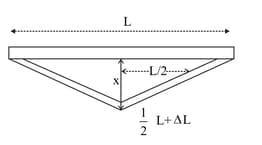NCERT Solutions for Chapter: Thermal Properties of Matter, Exercise 5: LA
NCERT Physics Solutions for Exercise - NCERT Solutions for Chapter: Thermal Properties of Matter, Exercise 5: LA
Attempt the practice questions on Chapter 11: Thermal Properties of Matter, Exercise 5: LA with hints and solutions to strengthen your understanding. NCERT Exemplar Physics - Class 11 solutions are prepared by Experienced Embibe Experts.
Questions from NCERT Solutions for Chapter: Thermal Properties of Matter, Exercise 5: LA with Hints & Solutions
We would like to prepare a scale whose length does not change with temperature. It is proposed to prepare a unit scale of this type whose length remains, say We can use a bimetallic strip made of brass and iron each of different length whose length (both components) would change in such a way that difference between their lengths remain constant. If and , what should we take as length of each strip?
We would like to make a vessel whose volume does not change with temperature. We can use brass and iron ( and ) to create a volume of How do you think you can achieve this?
Calculate the stress developed inside a tooth cavity filled with copper when hot tea at temperature of is drunk. You can take body (tooth) temperature to be C and Bulk modulus for copper .
A rail track made of steel having length is clamped on a railway line at its two ends.

On a summer day due to rise in temperature by , it is deformed as shown in the figure above. Find (displacement of the centre) if .
A thin rod having length at and coefficient of linear expansion has its two ends maintained at temperatures and , respectively. Find its new length.
According to Stefan's law of radiation, a black body radiates energy from its unit surface area every second where is the surface temperature of the black body and is known as Stefan's constant. A nuclear weapon may be thought of as a ball of radius . When detonated, it reaches temperature of and can be treated as a black body. Estimate the power it radiates.
According to Stefan's law of radiation, a black body radiates energy from its unit surface area every second where is the surface temperature of the black body and is known as Stefan's constant. A nuclear weapon may be thought of as a ball of radius . When detonated, it reaches temperature of and can be treated as a black body. If surrounding has water at , how much water can of the energy produced evaporate in ?
(, ) (Given: Power radiated Watt)
According to Stefan's law of radiation, a black body radiates energy from its unit surface area every second where is the surface temperature of the black body and is known as Stefan's constant. A nuclear weapon may be thought of as a ball of radius . When detonated, it reaches temperature of and can be treated as a black body. If all this energy is in the form of radiation, corresponding momentum is How much momentum per unit time does it impart on unit area at a distance of [Power radiated Watt ]
